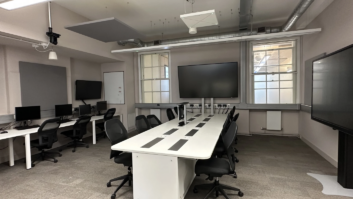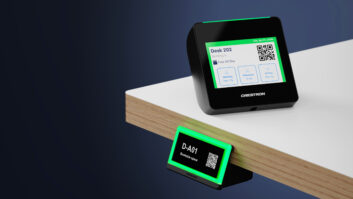
By Alexandra Parlour, Education marketing manager at Sony Professional Displays and Solutions
Since March 2020, education systems across the globe changed forever. Classrooms had to make the shift as students and teachers were required to switch to online and hybrid learning for the unforeseeable future. At Sony, we conducted new research in which we interviewed students across the United Kingdom, France and Germany to understand current feelings and needs to enable successful learning in the new environment, and examined what institutions are doing to meet expectations for a new hybrid learning approach to higher education.
The survey highlighted a few key areas where the gap between students’ technology needs, and IT Decision makers investment plans, painted a particularly contradictory picture about the future of hybrid education. In particular, it revealed that there are three top priorities that all universities should be considering to close this gap:
1. Properly supporting the return to on-premises with cutting edge technology
The biggest trends right now are around return to on-premises learning. Especially in a higher education setting, a hybrid approach to learning with a focus on remote teaching will be key for Universities, and technologies that capture clear high-quality audio, crisp video, and allow teachers/lecturers to provide interactive seminars and activities will be essential to offer the best possible immersion for students whether they are remote or onsite. Our research revealed that, in the UK specifically, 80% of students feel AV technology such as collaborative smart displays and projectors is important regardless of the learning style, while only 30% of ITDM’s decision makers say they plan to invest in AV tech for in-person learning. There is a clear gap in the needs of students and the investment plans of universities demonstrated here when it comes to on-premises technologies.
As Universities move into a way of teaching that supports the new hybrid world, projectors and displays will be relied on more than ever before to deliver in class creative content and engaging courses. As students begin to collaborate again, quality imagery and content becomes even more crucial to make sure socially distant students can see the front of the class and engage all the same. This feels particularly important as the survey discovered that over a third (34%) of students feel disconnected from their peers. This illustrates the need to facilitate and support student collaboration through tech with both distance and on-campus learning – helping students feel connected to one another.
To achieve this, organisations need to replicate the instant, collaborative, and seamless learning environment many students became accustomed to with remote learning in an on-premises environment. Because of this, at Sony, our Edge Analytics appliance using AI technology will be a big focus moving forward, and we’re dedicated to making sure our solutions are completely future proofed for our customers.
2. Improve remote support for the varying requirements of students
The Education sector has had to undergo a transformational shift in the way it supports its staff and students during the Covid-19 pandemic, with the majority having to quickly adapt to an online-only model. Staff and their students were sent home and forced into remote teaching and learning, and because of the quick response needed, many Universities were not prepared. The survey also found that students across Europe are spending an average of £423 to supplement the lack of digital resources within higher education institutions. This is likely due to the rush in which these remote technologies needed to be implemented. And, while research showed 68% of higher education decision makers in the UK are planning to invest in technology for distance learning in the next year, only 22% said they are treating it as a high priority.
At the height of the pandemic, Universities were repurposing existing tools like online content sharing platforms to bolster remote support, as well as investing in new technologies like cameras, audio and recording equipment. And the pandemic also changed the way teachers view technology in the classroom, as before the majority were reluctant to be captured on video, they’re now using it to their advantage. Their needs have changed significantly and as a vendor it’s our responsibility to make sure we can offer solutions that are tailored to their needs.
Now we have survived a world-wide, unplanned proof of concept for remote learning, universities can get to grips with whether what they have is good enough, how best to use it, and what other technologies might be needed to ensure they have the best offering possible for their students. It’s worth considering technology like beam-forming microphones that offer advanced speech reinforcement live in the room and recording using camera technology with top-quality lens specifications to suit large sized rooms – perfect for lecture capture. Things like Edge Analytics Appliance should also be considered, which uses AI technology that, when combined with remote cameras, can deliver curated video content in real-time to students. Features such as handwriting extraction, which ensures that any words and diagrams written on a board or screen remain in full view to the audience, are proving to be particularly useful for online lectures whether live or recorded.
It’s clear that further investment is needed in remote technologies like these while ensuring that the tech in place is the right fit for your students’ needs, illustrated by the fact that 40% of students surveyed said they don’t agree IT infrastructure and online tools from their institution provide them with a quality experience.
3. Ensure both remote and on-premises tech is working together for an optimal hybrid environment
While remote learning is important, the fact remains that we won’t be living in an all-digital-learning world any time soon. Students still want to attend physical education settings, with over a third (37%) of European students stated they still prefer in-person learning, against just 13% who prefer to be fully remote. In contrast to this fact, more than a third of ITDMs in Europe said distance learning tech is their current priority, with a whopping 92% stating they plan to invest in tech for distance learning in the next year. This is great, however imbalanced when compared with the much lower 55% of ITDMs saying their focus is with improving on-campus technologies.
In a post-Covid world, the Education sector isn’t returning totally to the way it was, but instead developing into a hybrid model of smaller classes for interactive sessions and online lectures for teaching. This hybrid model will be crucial in not only making sure students are well supported throughout their University experience, but also to attract more students from anywhere in the world that could enrol on their preferred courses without having to physically attend the University and endure the cost of travel and accommodation.
It’s not just the need to provide both on-premises and remote technologies, but to ensure that both environments work seamlessly together to enable efficient and productive collaboration no matter where a student is based. For example, by combining the latest in projector and LFD technology, and considering carefully how and where each product will work best both for impact and cost effectiveness, IT teams can ensure maximum collaboration and efficiency for students. With a well-thought-out hybrid LFD/Projector approach, University signage solutions can work smarter, not harder. The quality and ease of content sharing can be replicated in a remote environment with tech like SRG cameras and software like our AI Edge Analytics technology, to both capture and stream a high-quality learning experience for all.
Technology is key in making lessons more engaging, as well as providing support for teachers and enabling better student outcomes. Through implementing simple but effective digital tools, educational institutions across the world have a huge opportunity to not only maintain the continuity of teaching, but to stay competitive in a changing world where students need a balance of both online learning and on-campus solutions.
The impact of the pandemic has changed the entire higher education landscape, and we are consistently working to develop new innovative solutions that can enhance students’ understanding of educational content to better the learning experience while considering individual needs. The traditional education setting was forcibly rewritten during the pandemic, and we will continue to see a true evolution of how we cater to students both on and off campus from here on out.







